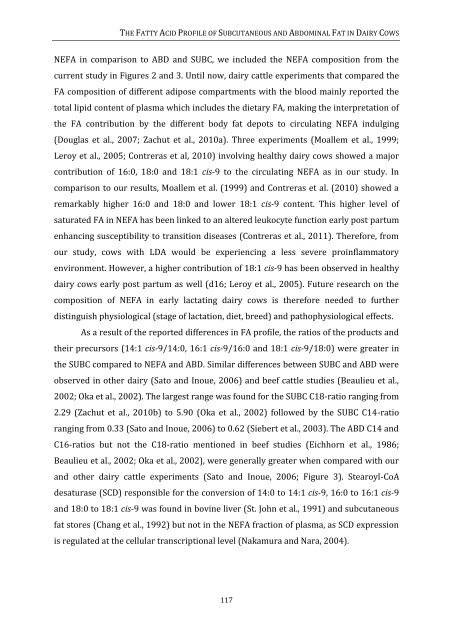view - Department of Reproduction, Obstetrics and Herd Health
view - Department of Reproduction, Obstetrics and Herd Health
view - Department of Reproduction, Obstetrics and Herd Health
You also want an ePaper? Increase the reach of your titles
YUMPU automatically turns print PDFs into web optimized ePapers that Google loves.
THE FATTY ACID PROFILE OF SUBCUTANEOUS AND ABDOMINAL FAT IN DAIRY COWS<br />
NEFA in comparison to ABD <strong>and</strong> SUBC, we included the NEFA composition from the<br />
current study in Figures 2 <strong>and</strong> 3. Until now, dairy cattle experiments that compared the<br />
FA composition <strong>of</strong> different adipose compartments with the blood mainly reported the<br />
total lipid content <strong>of</strong> plasma which includes the dietary FA, making the interpretation <strong>of</strong><br />
the FA contribution by the different body fat depots to circulating NEFA indulging<br />
(Douglas et al., 2007; Zachut et al., 2010a). Three experiments (Moallem et al., 1999;<br />
Leroy et al., 2005; Contreras et al, 2010) involving healthy dairy cows showed a major<br />
contribution <strong>of</strong> 16:0, 18:0 <strong>and</strong> 18:1 cis-9 to the circulating NEFA as in our study. In<br />
comparison to our results, Moallem et al. (1999) <strong>and</strong> Contreras et al. (2010) showed a<br />
remarkably higher 16:0 <strong>and</strong> 18:0 <strong>and</strong> lower 18:1 cis-9 content. This higher level <strong>of</strong><br />
saturated FA in NEFA has been linked to an altered leukocyte function early post partum<br />
enhancing susceptibility to transition diseases (Contreras et al., 2011). Therefore, from<br />
our study, cows with LDA would be experiencing a less severe proinflammatory<br />
environment. However, a higher contribution <strong>of</strong> 18:1 cis-9 has been observed in healthy<br />
dairy cows early post partum as well (d16; Leroy et al., 2005). Future research on the<br />
composition <strong>of</strong> NEFA in early lactating dairy cows is therefore needed to further<br />
distinguish physiological (stage <strong>of</strong> lactation, diet, breed) <strong>and</strong> pathophysiological effects.<br />
As a result <strong>of</strong> the reported differences in FA pr<strong>of</strong>ile, the ratios <strong>of</strong> the products <strong>and</strong><br />
their precursors (14:1 cis-9/14:0, 16:1 cis-9/16:0 <strong>and</strong> 18:1 cis-9/18:0) were greater in<br />
the SUBC compared to NEFA <strong>and</strong> ABD. Similar differences between SUBC <strong>and</strong> ABD were<br />
observed in other dairy (Sato <strong>and</strong> Inoue, 2006) <strong>and</strong> beef cattle studies (Beaulieu et al.,<br />
2002; Oka et al., 2002). The largest range was found for the SUBC C18-ratio ranging from<br />
2.29 (Zachut et al., 2010b) to 5.90 (Oka et al., 2002) followed by the SUBC C14-ratio<br />
ranging from 0.33 (Sato <strong>and</strong> Inoue, 2006) to 0.62 (Siebert et al., 2003). The ABD C14 <strong>and</strong><br />
C16-ratios but not the C18-ratio mentioned in beef studies (Eichhorn et al., 1986;<br />
Beaulieu et al., 2002; Oka et al., 2002), were generally greater when compared with our<br />
<strong>and</strong> other dairy cattle experiments (Sato <strong>and</strong> Inoue, 2006; Figure 3). Stearoyl-CoA<br />
desaturase (SCD) responsible for the conversion <strong>of</strong> 14:0 to 14:1 cis-9, 16:0 to 16:1 cis-9<br />
<strong>and</strong> 18:0 to 18:1 cis-9 was found in bovine liver (St. John et al., 1991) <strong>and</strong> subcutaneous<br />
fat stores (Chang et al., 1992) but not in the NEFA fraction <strong>of</strong> plasma, as SCD expression<br />
is regulated at the cellular transcriptional level (Nakamura <strong>and</strong> Nara, 2004).<br />
117









